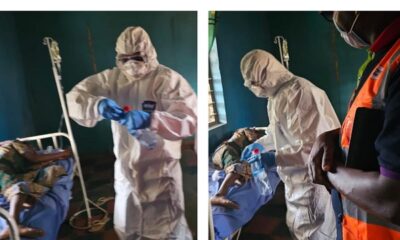Health
Galvanizing global ambition to end the AIDS epidemic after a decade of progress
A new report from the United Nations Secretary-General, Galvanizing global ambition to end the AIDS epidemic after a decade of progress, has been presented to United Nations Member States during the 73rd session of the United Nations General Assembly. The Member States gathered at the United Nations in New York, United States of America, to review progress and share their own progress and challenges.
“A world without AIDS was almost unimaginable when the General Assembly held its first special session on the epidemic 18 years ago,” said United Nations Secretary-General António Guterres in the report. “Since then, the global determination to defeat one of history’s greatest health crises has produced remarkable progress … and … inspired a commitment within the 2030 Agenda for Sustainable Development to end the AIDS epidemic by 2030.”
The Secretary-General’s report shows that results once derided as impossible in low-income settings have now been achieved following a decade of progress in the response to HIV. Between 2008 and 2017, there was a 43% reduction in AIDS-related deaths, a 45% reduction in new HIV infections among children and a 19% reduction in new HIV infections among adults globally. The number of people living with HIV on treatment also increased, by 5.5 times, reaching 21.7 million of the 36.9 million people living with HIV in 2017.
“The enormous achievements in the response to HIV in recent decades, under the strong leadership of UNAIDS, is one of the best examples of multilateralism in action,” said María Fernanda Espinosa, President of the United Nations General Assembly. “It is most definitely an indication of what we can achieve when we work together around a common cause.”
The report shows that progress has been most marked in eastern and southern Africa, where AIDS-related deaths fell by 53% and new HIV infections among adults and children fell by 36%. An epidemic that once killed more than a million people in the region per year now claims fewer than 400 000 lives per year.
In other regions of the world, including Latin America, the Caribbean, Asia and the Pacific, western and central Europe and North America, increases in the coverage of HIV testing and treatment services have achieved significant reductions in AIDS-related deaths over the past decade. Most of those regions have also experienced declines in new HIV infections.
Notable exceptions are eastern Europe and central Asia, where the annual number of new HIV infections has risen by 30% since 2010, with an estimated 960 000 people newly infected over this time, and in the Middle East and North Africa, where deaths from AIDS-related illnesses increased by 11%, an estimated 140 000 people newly infected, over the same period.
The report notes that services focused on key populations within those regions are few and far between, and harsh punishments for same-sex sexual relationships, drug use and sex work in those regions and elsewhere are proving to be formidable barriers to the few services that are available.
In western and central Africa, insufficient domestic funding, weak health systems, formal and informal user fees for health care, humanitarian situations and high levels of stigma and discrimination continue to undermine efforts to scale up HIV testing and treatment.
Many challenges remain, including stigma and discrimination faced by people living with HIV and harmful gender norms. Laws and policies in many countries prevent young people, women, key populations―gay men and other men who have sex with men, sex workers, transgender people, people who inject drugs and prisoners and other incarcerated people―indigenous people, migrants and refugees from accessing health and HIV services.
Funding for HIV responses in low- and middle-income countries globally has also remained flat for most of the past five years. In 2017, donor and domestic investments in low- and middle-income countries were US$ 20.6 billion, about 80% of the 2020 target.
“As the Secretary-General’s report makes abundantly clear, to protect the gains we have made and to tackle the challenges that stand in the way of our promise to end AIDS by 2030, we need to firm up our resolve, strengthen our partnerships and say no to complacency,” said Gunilla Carlsson, UNAIDS Executive Director, a.i. “Let’s start with a successful replenishment that results in a fully funded Global Fund to Fight AIDS, Tuberculosis and Malaria that will enable it, along with its range of partners, including UNAIDS, to continue to deliver evidence-informed, people-centred and human-rights based support to the people and communities who need it the most.”
The report outlines that there is an important opportunity to seize the growing momentum to achieve universal health coverage, a core principle of which is leaving no one behind. Collaboration between health systems and community groups has been shown to reduce stigma and discrimination and to help to deliver services to the people in greatest need―a key recommendation of the report is the strengthening of the vital role that community groups play in the AIDS response.
In the report, the United Nations Secretary-General urges Member States to adopt the following recommendations to galvanize political will, accelerate action and build the momentum necessary to reach the 2020 targets agreed to by the United Nations General Assembly in the 2016 United Nations Political Declaration on Ending AIDS: (a) reinvigorate primary HIV prevention; (b) diversify HIV testing and differentiate the delivery of health care to reach the 90–90–90 targets; (c) establish enabling legal and policy environments in order to reach marginalized and vulnerable populations; (d) mobilize additional resources and allocate them where they are most needed; (e) support communities to enable them to play their critical roles; and (f) incorporate a comprehensive HIV response into universal health coverage
Health
Oyo: Tragedy As Bride-to-Be Among Four Dead in Suspected Lassa Fever Outbreak
The Oyo State Ministry of Health has closed two hospitals in Saki West Local Government Area following a suspected outbreak of Lassa fever, which has claimed four lives.
The fatalities, confirmed by the Oyo State Rapid Response Team (RRT), include three males and a 32-year-old female who was preparing for her wedding. The closure of the hospitals aims to contain the spread of the disease and ensure thorough decontamination.
In a press statement issued by the Commissioner for Information and Orientation, Dotun Oyelade, the State Commissioner for Health, Dr. Oluwaserimi Ajetunmobi, revealed that the RRT was dispatched to Saki following distress calls from residents reporting mysterious deaths.
Findings and Immediate Actions
The RRT, comprising health officials, representatives from WHO and the Red Cross, and local health authorities, conducted a comprehensive investigation into the outbreak.
Preliminary findings suggest that an apprentice at one of the affected hospitals, who had recently returned from Iwajowa Local Government Area, might have introduced the infection.
The team disclosed that the deceased exhibited symptoms consistent with Lassa fever, such as craniofacial bleeding. The hospital owner, who was among the deceased, initially self-medicated with antimalarials and antibiotics before seeking hospital care when his condition worsened.
Containment Measures
Both the hospital where the fatalities occurred and the facility that admitted the hospital owner were shut down for decontamination.
Contact tracing efforts are ongoing, focusing on high-risk individuals who had contact with the deceased during their illness or burial.
Affected health workers were trained on Infection Prevention and Control (IPC) protocols, and public awareness campaigns were conducted to educate residents about Lassa fever.
Samples have been collected from a symptomatic individual, pending laboratory confirmation. Line-listing of contacts is underway to identify potential cases and prevent further spread.
Collaborative Efforts
The RRT also paid an advocacy visit to the Okere of Saki’s palace to brief traditional authorities on the situation. Local government officials in Saki West were engaged to coordinate containment strategies.
Reports indicate that while the outbreak initially affected Saki West, it has extended to Iwajowa and Kajola Local Government Areas.
Disease Surveillance and Notification Officers (DSNOs) in the affected LGAs have been instructed to commence preliminary containment measures as the State RRT ramps up its response.
Call for Vigilance
The Ministry of Health has urged residents to remain vigilant, report any symptoms suggestive of Lassa fever, and adhere to preventive measures.
These include proper hygiene practices, avoiding contact with rodents, and seeking medical attention promptly if symptoms arise.
Health
Oyo: Oseni to Launch Mobile Clinic Initiative to Revitalize Rural Healthcare
A member representing Ibarapa East/Ido federal constituency of Oyo State at the House of Representatives, Engr. Aderemi Oseni, has announced a plan to launch a “Mobile Clinic” programme aimed at providing essential healthcare services directly to rural communities across the constituency.
Scheduled to begin in the first quarter of 2025, this initiative underscores Oseni’s commitment to expanding healthcare access, particularly for underserved populations.
Speaking on Saturday at the 10th-anniversary celebration of God’s Knot Hospital in Ologuneru, Ibadan, the lawmaker, who also chairs the House Committee on the Federal Roads Maintenance Agency (FERMA), highlighted the programme’s primary objective: bringing healthcare closer to the people.
“Every community deserves attention; healthcare should never be bound by geographical barriers,” Oseni stated.
He explained that the mobile clinics would deliver essential health check-ups, screenings, and preventive care in remote areas, allowing residents to access quality healthcare without traveling long distances.
As part of his broader healthcare agenda, Oseni informed, through a statement by his media aide, Idowu Ayodele, that he has already facilitated the construction of two fully equipped maternity centers within his constituency, both slated for commissioning before December 2024. He also disclosed plans to establish two modern general hospitals in 2025, further strengthening his commitment to building a healthier community.
The lawmaker expressed interest in collaborating with God’s Knot Hospital on the mobile clinic project, calling for partnerships to support sustainable healthcare initiatives that enhance the quality of life for vulnerable populations in the constituency.
“I resonate deeply with the mission of God’s Knot Hospital,” Oseni shared, adding that such partnerships would significantly improve healthcare in Oyo State”.
The anniversary event attracted distinguished guests, including former Ondo State Governor Dr. Olusegun Mimiko, whom Oseni commended for his contributions to healthcare, particularly through the Mother and Child Hospitals that transformed maternal and child healthcare in Ondo State.
Oseni urged philanthropists, government bodies, and international organizations to support healthcare projects like the upcoming mobile clinics, emphasising that the improvement of healthcare services is a shared responsibility.
Health
NAFDAC Shuts Maiduguri Market Over Sun-Dried Drugs After Flood
The National Agency for Food and Drug Administration and Control (NAFDAC) has ordered the immediate closure of the Gomboru drug market in Maiduguri following severe flooding that submerged the area and contaminated the drugs sold within the market.
In a statement posted on its official X handle, NAFDAC disclosed that the decision was made after reports surfaced that contaminated drugs, which had been washed and sun-dried for resale, were being sold at the market.
“After the recent flooding in Maiduguri that submerged the Gomboru drug market where contaminated drugs were washed and sun-dried for resale, the @DGatNAFDAC ordered the immediate closure of the market to conduct a thorough shop-to-shop removal of these compromised drugs,” the agency wrote.
The flooding, which ravaged Maiduguri, was triggered by the rupture of the Alau dam on the Ngadda River, located 20 kilometers (12 miles) south of the city.
The floodwaters claimed at least 30 lives and displaced 400,000 residents, leaving large parts of the city and surrounding areas in devastation.
NAFDAC’s intervention is aimed at safeguarding public health by preventing the sale and consumption of contaminated drugs.
The agency has mobilized teams to inspect the market and ensure the removal of all compromised pharmaceutical products.
-



 Politics6 days ago
Politics6 days agoOyo Rep. Member, Akinmoyede Appoints Three More Aides
-



 Crime & Court1 week ago
Crime & Court1 week agoEFCC Chair Raises Alarm on Rampant Fraud in Nigeria’s Electricity Sector
-



 Health6 days ago
Health6 days agoOyo: Tragedy As Bride-to-Be Among Four Dead in Suspected Lassa Fever Outbreak
-



 Politics4 days ago
Politics4 days ago#OndoDecides2024: Rep Oseni Hails Aiyedatiwa’s Victory, Commends Residents for Peaceful Polls